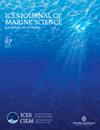The stress response of the seagrass Zostera noltei and three commercial clam species to low salinity associated with heavy rainfall
IF 3.4
2区 农林科学
Q1 FISHERIES
引用次数: 0
Abstract
The maintenance of stocks of estuarine species strongly depends on the ability of the species to cope with environmental stress. In NW Spain, commercial clam beds, which are usually co-occupied by the seagrass Zostera noltei, are often exposed to reduced salinity caused by intense rainfalls. Our goals were to evaluate the effects of low salinity events on both juvenile clams and Z. noltei, including their interactions. A mesocosm experiment was performed to simulate three salinity decreases (35–35, 25–10, and 20–5), and several indicators of clam and seagrass performance were measured after 3 and 6 days of exposure and again after a recovery period of 4 days. No differences were observed in the non-native clam Ruditapes philippinarum, while oxygen consumption, clearance rate and growth decreased significantly in the native clams R. decussatus and Venerupis corrugata in response to low salinity stress. Zostera noltei indicators did not vary in response to low salinity exposure, except the sucrose content, which decreased. Moreover, the seagrass buffered juvenile clams from salinity fluctuations in the short term, although the interactions were weak. The species-specific sensitivity to low salinity should be a major concern in future management plans for the shellfish beds in the context of climate change.海草 Zostera noltei 和三种商业蛤类对暴雨导致的低盐度的应激反应
河口物种种群的维持在很大程度上取决于物种应对环境压力的能力。在西班牙西北部,通常由海草 Zostera noltei 共同占据的商业蛤床经常受到强降雨造成的盐度降低的影响。我们的目标是评估低盐度事件对幼蛤和 Z. noltei 的影响,包括它们之间的相互作用。我们模拟了三次盐度下降(35-35、25-10 和 20-5),并在暴露 3 天和 6 天后以及 4 天恢复期后测量了蛤类和海草的几项性能指标。非本地蛤类 Ruditapes philippinarum 在低盐度胁迫下的耗氧量、清除率和生长速度明显下降,而本地蛤类 R. decussatus 和 Venerupis corrugata 在低盐度胁迫下的耗氧量、清除率和生长速度明显下降。Zostera noltei 的各项指标在低盐度胁迫下均无变化,只是蔗糖含量有所下降。此外,海草还能在短期内缓冲幼蛤对盐度波动的影响,尽管这种相互作用很微弱。在气候变化的背景下,物种对低盐度的敏感性应成为贝类海床未来管理计划的主要关注点。
本文章由计算机程序翻译,如有差异,请以英文原文为准。
求助全文
约1分钟内获得全文
求助全文
来源期刊

ICES Journal of Marine Science
农林科学-海洋学
CiteScore
6.60
自引率
12.10%
发文量
207
审稿时长
6-16 weeks
期刊介绍:
The ICES Journal of Marine Science publishes original articles, opinion essays (“Food for Thought”), visions for the future (“Quo Vadimus”), and critical reviews that contribute to our scientific understanding of marine systems and the impact of human activities on them. The Journal also serves as a foundation for scientific advice across the broad spectrum of management and conservation issues related to the marine environment. Oceanography (e.g. productivity-determining processes), marine habitats, living resources, and related topics constitute the key elements of papers considered for publication. This includes economic, social, and public administration studies to the extent that they are directly related to management of the seas and are of general interest to marine scientists. Integrated studies that bridge gaps between traditional disciplines are particularly welcome.
 求助内容:
求助内容: 应助结果提醒方式:
应助结果提醒方式:


